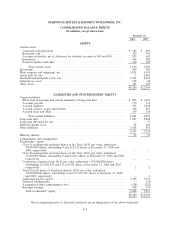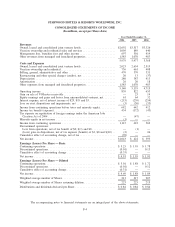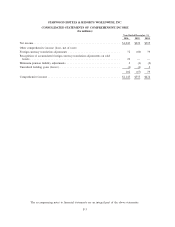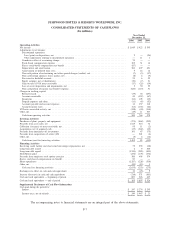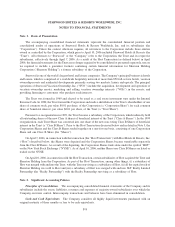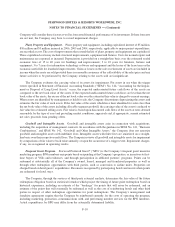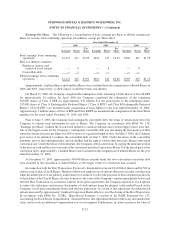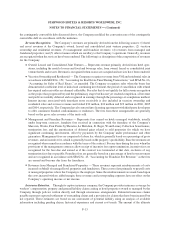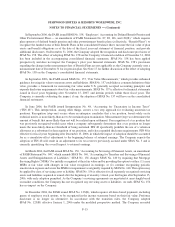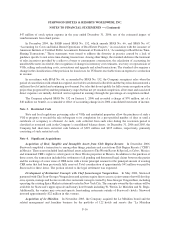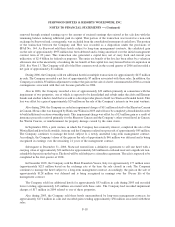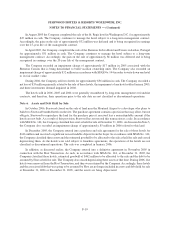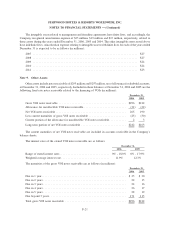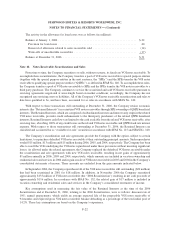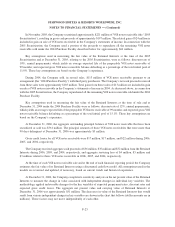Starwood 2006 Annual Report Download - page 74
Download and view the complete annual report
Please find page 74 of the 2006 Starwood annual report below. You can navigate through the pages in the report by either clicking on the pages listed below, or by using the keyword search tool below to find specific information within the annual report.the contingently convertible debt discussed above, the Company modified the conversion rate of the contingently
convertible debt in accordance with the indenture.
Revenue Recognition. The Company’s revenues are primarily derived from the following sources: (1) hotel
and resort revenues at the Company’s owned, leased and consolidated joint venture properties; (2) vacation
ownership and residential revenues; (3) management and franchise revenues; (4) revenues from managed and
franchised properties; and (5) other revenues which are ancillary to the Company’s operations. Generally, revenues
are recognized when the services have been rendered. The following is a description of the composition of revenues
for the Company:
kOwned, Leased and Consolidated Joint Ventures — Represents revenue primarily derived from hotel oper-
ations, including the rental of rooms and food and beverage sales, from owned, leased or consolidated joint
venture hotels and resorts. Revenue is recognized when rooms are occupied and services have been rendered.
kVacation Ownership and Residential — The Company recognizes revenue from VOI and residential sales in
accordance with SFAS No. 152, “Accounting for Real Estate Time Sharing Transactions,” and SFAS No. 66,
“Accounting for Sales of Real Estate,” as amended. The Company recognizes sales when the buyer has
demonstrated a sufficient level of initial and continuing involvement, the period of cancellation with refund
has expired and receivables are deemed collectible. For sales that do not qualify for full revenue recognition
as the project has progressed beyond the preliminary stages but has not yet reached completion, all revenue
and profit are initially deferred and recognized in earnings through the percentage-of-completion method.
Interest income associated with timeshare notes receivable is also included in vacation ownership and
residential sales and services revenue and totaled $30 million, $24 million and $19 million in 2006, 2005
and 2004, respectively. The Company has also entered into licensing agreements with third-party developers
to offer consumers branded condominiums or residences. The fees from these arrangements are generally
based on the gross sales revenue of the units sold.
kManagement and Franchise Revenues — Represents fees earned on hotels managed worldwide, usually
under long-term contracts, franchise fees received in connection with the franchise of the Company’s
Sheraton, Westin, Four Points by Sheraton, Le Méridien, St. Regis, W and Luxury Collection brand names,
termination fees and the amortization of deferred gains related to sold properties for which we have
significant continuing involvement, offset by payments by the Company under performance and other
guarantees. Management fees are comprised of a base fee, which is generally based on a percentage of gross
revenues, and an incentive fee, which is generally based on the property’s profitability. Base fee revenues are
recognized when earned in accordance with the terms of the contract. For any time during the year, when the
provisions of the management contracts allow receipt of incentive fees upon termination, incentive fees are
recognized for the fees due and earned as if the contract was terminated at that date, exclusive of any
termination fees due or payable. Franchise fees are generally based on a percentage of hotel room revenues
and are recognized in accordance with SFAS No. 45, “Accounting for Franchise Fee Revenue,” as the fees
are earned and become due from the franchisee.
kRevenues from Managed and Franchised Properties — These revenues represent reimbursements of costs
incurred on behalf of managed hotel properties and franchisees. These costs relate primarily to payroll costs
at managed properties where the Company is the employer. Since the reimbursements are made based upon
the costs incurred with no added margin, these revenues and corresponding expenses have no effect on the
Company’s operating income or net income.
Insurance Retention. Through its captive insurance company, the Company provides insurance coverage for
workers’ compensation, property and general liability claims arising at hotel properties owned or managed by the
Company through policies written directly and through reinsurance arrangements. Estimated insurance claims
payable represent expected settlement of outstanding claims and a provision for claims that have been incurred but
not reported. These estimates are based on our assessment of potential liability using an analysis of available
information including pending claims, historical experience and current cost trends. The amount of the ultimate
F-13
STARWOOD HOTELS & RESORTS WORLDWIDE, INC.
NOTES TO FINANCIAL STATEMENTS — (Continued)


